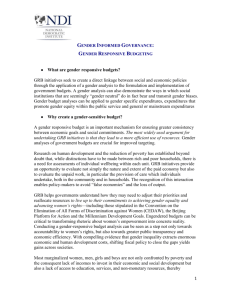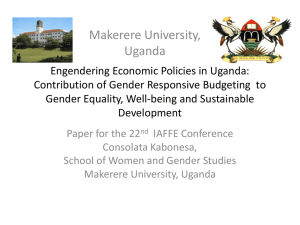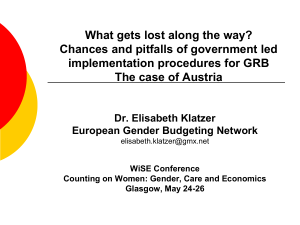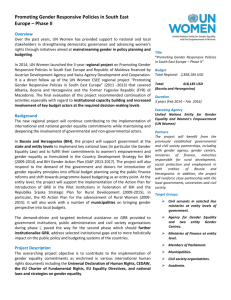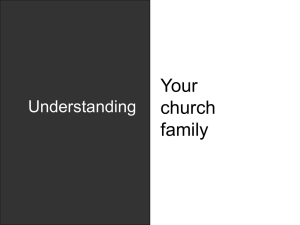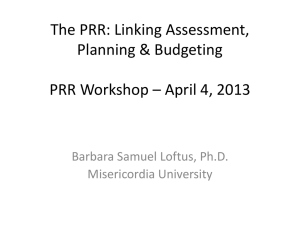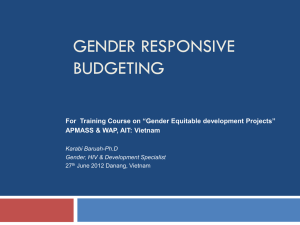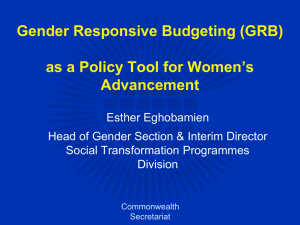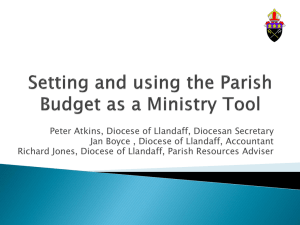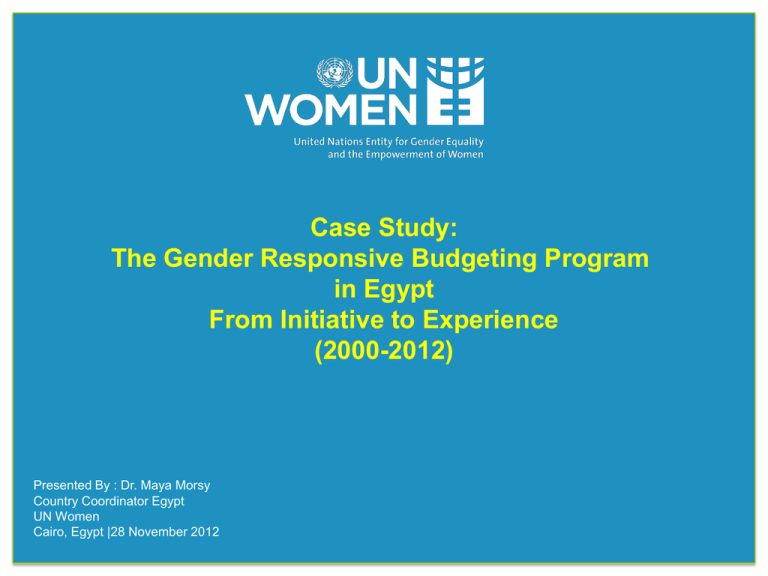
Case Study:
The Gender Responsive Budgeting Program
in Egypt
From Initiative to Experience
(2000-2012)
Presented By : Dr. Maya Morsy
Country Coordinator Egypt
UN Women
Cairo, Egypt |28 November 2012
What is Gender Responsive Social Budgeting?
Gender Responsive Budgeting Defined:
•
Gender-responsive budgeting (GRB) is government planning, programming and budgeting that
contributes to the advancement of gender equality and the fulfillment of women's rights. It entails
identifying and reflecting needed interventions to address gender gaps in sector and local government
policies, plans and budgets.
GRB also aims to analyze the gender-differentiated impact of revenue-raising policies and the allocation of
domestic resources and Official Development Assistance.
Social Budgeting Defined:
•
The term “Social Budgeting” doesn’t have one single definition but it could be “described as the process
by which society’s goals and priorities as well as the rights of all of the population—including those that
could be facing social exclusion and discrimination—are better reflected throughout the budgeting
process. Often, those with least voice include poor households and children, women, and socially excluded
groups and communities).”
Social Budgeting is not just about the allocations within the budget for the vulnerable groups, however, it’s
about the process by which the goals and priorities of the society are reflected within the budget.
Thus, Gender Responsive Social Budgeting is the process by which society’s goals and priorities are reflected
and where the government planning, programming and budgeting contributes to the advancement of
gender equality and the fulfillment of women's rights
Brief Description- Gender Responsive
Budgeting in Egypt
UN Women has been working on the implementation of Gender Responsive Budgets and gender
mainstreaming in the national plans to ensure the delivery of services to the most vulnerable groups.
•
2000-2004: Establishing of Equal Opportunities Unit. These units would be affiliated to the Office of the
Minister.
•
2005 -2011: Building the capacity of the relevant MOF and the selected staff from other Ministries to
track, monitor, and evaluate national and local public budgets from a gender and poverty perspective and
produce policy recommendations on equal opportunity for women in the budget, create insight of equal
opportunities in the national budget revenues and expenditures and facilitate transparency in budget
formulation processes.
•
2011-Present: Initiating the Gender Responsive Social Budgeting Strategy , finalizing the capacity
development of all local budget employees in 27 governorates in the 5 sectors (Health- EducationManpower- Social security- Food security) and launching the first Arabic e-learning platform
The initiative is a multi- stakeholder initiative in partnership with the Ministry of Finance, the National
Council for Women, Academic institutes and UN Women.
3
Program Strategies
Ministry of Finance Leading
2005-2011
1.
2.
3.
4.
5.
6.
7.
8.
9.
Advocacy
Tools and Methodology
Capacity Development
Financial Reform.
Institutional Development.
Legislative Reform.
Public Policy Interventions.
Awareness Raising.
Process Documentation.
Legislative Reform
•
•
•
•
•
Establishment of Family Court
Establishment of Alimony Fund
Personal Status Law
Pension Law
Tax Law
5
Tools and Methodology
• Situational Analysis for men and women in the society
(Updated every 2 years).
• Needs Assessment on Local and Governorate level 27 Plans .
• Gender Mainstreaming in the socio economic national plan
(2002-2007) -(2007-2012)
• Development of Gender indicators.
• Analysis of public fiscal policies from a gender perspective.
• Analysis of the budget cycle.
• Engendering the call circular and the budget law.
• Amendment to the Constitution for the legislative role of the
Parliament with Regard to the Budget. (commenting and
approval)
Tools and Methodology
• Development of budget templates to ensure the inclusion of
sex disaggregated data of beneficiaries on the “Benefit
Incidence Analysis” basis.
• Analysis of public expenditures from a gender perspective.
• Analysis of Women specific allocations / Gender Equality
allocations
• Analysis of Public expenditure and its impact on gender.
• Project on the Automation of the budget process
• Development of a Monitoring & Evaluation mechanism.
The measures that are currently in place
•
•
•
•
•
A GRB knowledge package was developed through a participatory approach with
core of experts established from the Institute of Planning, the Ministry of
Economic Development and the Budget Experts from the Ministry of Finance
The capacities of MOF employees working on the processes of planning, reviewing
and the execution processes of the budget were built.
A cadre of budget employees willing and capable of producing a gender sensitive
budget was created.
Focused on the following sectors: Education, Health, Water, Manpower, Food
Security and Social Security as the target sectors for applying GRB in Egypt since
they are the service sectors that mostly affect the society.
The Call Circular and the process of the budget were analyzed, which were
important steps to initiate the required legislative reforms
The measures that are currently in place
•
•
•
•
•
•
A Gender Analysis of the National budget (2006-2007) and the National Development Plan
(2007-2012), in addition to a Gender Analysis study of the existing financial government
policies were conducted.
A specialized Forum of women parliamentarians was organized to discuss GRB and highlight
the role of the parliament.
Technical materials were translated to the Arabic language like Diane Elson UNIFEM Book,
“Budgeting for Women’s Rights: Monitoring Government Budgets for the Compliance with
CEDAW.”
Media seminars were held to raise awareness about GRB and to advocate for the concept
within the different media channels
Civil Society workshops were organized to introduce the representatives to the GRB concept
and the steps taken by MOF to apply such concept. The workshops were unprecedented to
ensure transparency and cooperation between the government and the civil society.
RITSEC: An E-learning system the first GRB Arabic e-learning hub
Challenges, Lessons Learned, and Best Practices
Challenges:
1) The Turn over in Political Leadership,
2) The resistance culture within government employees
3) The lack of knowledge and belief on concepts related to gender equality and
women’s empowerment
4) Acceptance to move from line Item budget to Program based budget
5) The availability of sex- disaggregated data.
Lessons Learned:
1) An incentives policies to change from traditional line item budgets to GRB must be
developed.
2) A strong political will is necessary for the implementation of GRB
3) Legislative and Financial Reforms must be introduced
4) Gender Analysis must be conducted and linked to the presentation of the
national budget
Best Practices:
1.
2.
3.
4.
Building a cadre of trainers inside the budget department creates
national ownership and sustainability. (500 employees)
Introducing legislative reforms through the engendering of the budget
process in the budget circular is a key factor to the sustainability and
institutionalization of the model
Conducting on the job trainings (OJT) in local governorates has been
regarded as a best practice because it does not only focus on theoretical
trainings and encouraged budget employees to develop the gender
sensitive budget templates in parallel to the traditional line item budgets.
The institutionalization of the GRB in the Ministry of finance and the
presence of the provisions of GRB in the call circular from 2008 till
present
Thank You
12

